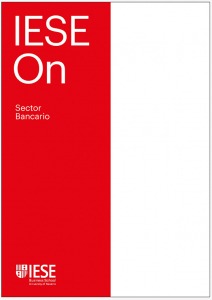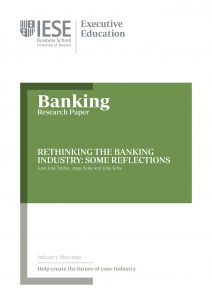Surfing the Wave of Uncertainty
The year 2023 was a great year for Spanish banking, given the fact that the five largest banks obtained a combined profit of more than €26.08 billion (0.75% return on assets), which is undoubtedly great news for the financial stability of the system, great news for bank shareholders, who will obtain a higher dividend, and great news for society as a whole because, when banks make a profit, it increases their capacity to support the country’s economy. The normalization of interest rates has contributed to this extraordinary result for the banking industry, which has also led to efficiency ratios of the Spanish banking sector of 37% to 45%, a sign of the strength of our retail banking sector worldwide. Spanish banks’ ROE is approaching its cost of capital. On average, it’s better than European banks’, though still below the figures for large US banks. However, American regional banks are experiencing levels of credit card default (8.16%) and an associated debt balance decline (9.36%) that has been unheard of in the last 40 years.
As for large European banks, market value and book value are finally converging, which can be explained, among other reasons, by the fact that, when growth opportunities are lacking, the shareholder remuneration policy is a decisive factor in the industry’s valuation. However, non-performing loans on the balance sheets of banks from their banking activity in Spain range from 2.11% to 4.22% with a cost of credit risk that is rising very gently and reached 0.28% to 0.62% in the last quarter of 2023. This has prompted Spanish bank managers to be ready to make decisions to sell portfolios of non-performing assets early, given that there is an active market for NPLs.
Traditional banks, with their intense regulatory and supervisory pressure, which provides high-quality information on the NPLs on their balance sheets, represent only one part of the financial system. There is another part that is growing discreetly in the shadow of this heightened banking regulation, where little is known of the default level of the loans it originates, the debt it acquires from banks and its collection management practices. This lack of symmetry is inappropriate, especially when, the larger the organization working in the shadow banking system, the less information is available on its methods.
In addition, with regard to the decarbonization of the economy, regulation and supervision highlight the importance of assessing the impact of transition risk on banks’ credit and securities portfolios, which is another example of the lack of symmetry with shadow banking.
We will discuss all of this at 19 Banking, along with the economic situation in Ukraine, the social impact of banking, the entry into force of Basel 3.5, the digital euro project, the situation of payment systems, the digitalization of the industry, macroeconomic expectations and other current issues, with the CEOs of Spanish banks and prominent representatives of countries and national and international financial institutions, as well as academics and industry experts.













































